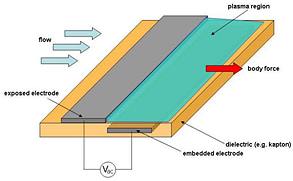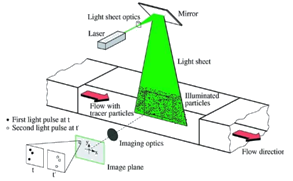Sponsor: N/A
Collaborators: N/A
Plasma actuators are a simple technology with a wide array of aerodynamic applications. The simplest geometry for a plasma actuator is known as a single dielectric barrier discharge actuator (SDBD) as shown in Figure 1. Two thin electrodes, offset from each other, are separated by a dielectric in the middle, such as Kapton. The covered electrode is usually grounded while the exposed electrode is connected to a high voltage, high frequency power supply (1-20 kVolts, 1-20 kHz). The operation of plasma actuators relies on the electric breakdown of air. Initially, the power supply generates an electric field between the two electrodes that accelerates free electrons naturally found in air. As the electrons travel through the air, they collide with neutral air particles. If the electric field strength is close to 30 kV/cm the electrons will, on average, gain enough energy between collisions such that they ionize the neutral particles to create an ion-electron pair. The electrons continue to accelerate and ionize other particles creating an avalanche ionization region between the electrodes. Eventually, enough electrons reach the dielectric and build up charge to weaken the electric field and stop the avalanche. At this point, the power supply switches polarity and the electrons are accelerated in the other direction starting the process all over again. The ions are heavier than the electrons so they do not travel as much but they do impart some of their momentum onto neutral particles, inducing airflow. In effect, the plasma actuator creates a jet of air using only electric power and no moving parts. It is the simplicity of the plasma actuator and the ability to control it electrically that makes it favorable for many flow control applications.
Particle Image Velocimetry
The high voltage characteristics of plasma actuators make it difficult to gather data using conventional sensors, especially inside the plasma. Particle image velocimetry (PIV) is a popular flow measurement method that can give velocity fields for a large area. The basic operating concept of PIV is shown in Figure 2. First, the flow is seeded with small particles that are specifically chosen to properly follow the flow. Then, a camera takes two pictures in rapid succession and notes the time difference between them. A computer breaks the pictures up into smaller interrogation areas and compares the position of the particles in the areas. Using the noted time difference, a velocity is calculated for each interrogation area. In a matter of minutes, the velocity field for the entire experimental area is available.
PIV particles come in contact with the plasma actuator and can react with the plasma to change the performance. The effect of different seed particles on plasma actuators can be seen in the research by Durscher and Roy, who built a serpentine plasma actuator to induce three-dimensional flowsi. The authors used PIV, with atomized oil particles, to analyze the flow and smoke from incense for qualitative flow visualization. Figure 3, shows the results of both. Immediately, one notices the different directions of the flow, with the smoke in fact flowing in the opposite direction to that of the oil particles. The only difference between the two pictures is the choice of particles. Atomizers precisely create oil particles of less than 1 micron in diameter and can be used to control particle density. Burning of incense creates a wide range of particle sizes and does not allow for control of particle density. Large particle size, high particle density, or a combination of both could be the reason for flow reversal. A critical assumption for PIV is that the particles follow the flow without disturbing it. Although PIV particles can never perfectly follow the flow, it is possible to properly select particles that follow the flow without disturbing it much. The question becomes, at what point do particles not properly follow the plasma actuator flow? To answer that question the physics concerning dusty plasmas must be taken into account.
A literature survey was conducted and found that none of the papers dealing with plasma actuators and PIV mentioned any affect from the plasma on the particle. Only Moghaddam, Kiger, and Ohadi considered the effects of plasma on particlesii. In their research, laser Doppler velocimetry (LDV) was used to calculate corona wind velocities. LDV is similar to PIV in that both use particles and lasers, but unlike PIV, LDV measures the Doppler shift in the laser as a particle passes through. Corona discharge is created between to wires with a high enough DC voltage to create plasma but not enough to arc through. The authors used the analysis found in Hinds to calculate the electric forces on the particles and correct velocity resultsiii. Unfortunately, their analysis does not apply to plasma actuators because it uses the equilibrated DC state. Plasma actuators use AC voltage and don’t have time to reach the equilibrium assumed in the analysis. The proposed research will use the dusty plasma physics presented above to analyze the flow of particles.
i. Durscher, R., Roy, S., 49th AIAA Aerospace Sciences Meeting including the New Horizons Forum and Aerospace Exposition, January 2011
ii. Moghaddam, S., Kiger, K. T., Ohadi, M., HVAC&R Research, Vol. 12, No. 1, January 2006
iii. Hinds, W.C. 1999. Aerosol Technology, chapter 15, pp. 323–334. New York: John Wiley & Sons, Inc.


